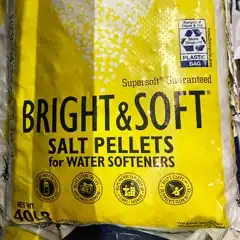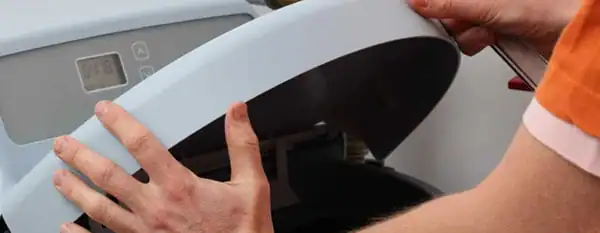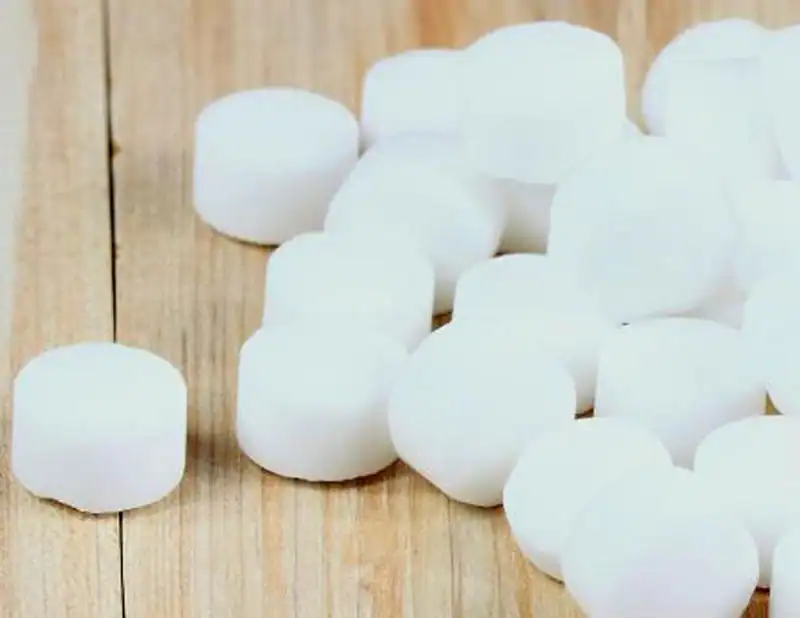If you’ve ever struggled with soap that won’t lather or spots on your dishes and glassware, you may have hard water. Hard water is water that contains high levels of minerals such as calcium and magnesium, which can leave deposits on pipes and appliances and make it difficult to lather soap and shampoo.
One solution to hard water is to use a water softening system, which removes these minerals through a process called ion exchange. And at the heart of this process is water softener salt.
For this article I thought I’d dive into some of the basics of water softener salt and answer some questions that you may have. I’ll dive into the various types of salt used in water softeners as well as choosing what’s right for you. Whether you’re looking to improve the performance of your water softening system or simply want to learn more about this essential household product, this post has you covered.
What Is Water Softener Salt
Water softener salt is a type of salt that is used in water softening systems to remove minerals that cause hard water. Hard water is water that contains high levels of minerals such as calcium and magnesium, which can leave deposits on pipes and appliances.
Ultimately, the best type of water softener salt for your specific system will depend on your budget, the availability of different types of salt in your area, and the specific needs of your water softening system. For more about how to choose a good water softener salt and the factors involved in that decision, see our article A Guide To Water Softener Salt: Pellets, Blocks, Cubes or Crystals.
How Does Water Softener Salt Work to Remove Hard Water Minerals?
When hard water enters a water softener, it comes into contact with small polystyrene beads, which are coated with sodium ions. Sodium ions attract and bind to minerals in the hard water, such as calcium and magnesium, and remove them from the water through a process called ion exchange.
To keep the water softening system functioning properly, it is necessary to periodically replenish the supply of sodium ions. This is where water softener salt comes in. When water softener salt is added to the system, it dissolves and releases sodium ions, which can then be used to replace the hard water minerals that have been removed.
We go into more detail about the water softening process within our article Water Softener Salt: Its Effects on Pipe Corrosion. In addition, there is a very good article provided by Penn State University entitled Water Softening that gives more detail about the softening process and hardness levels in your water.
How Does the Water Softener Salt Affect the Maintenance of My System?
Choosing the right type of water softener salt for your system is important to ensure that it is functioning properly and effectively removing hard water minerals. It is also important to fill the brine tank with salt on a regular schedule and keep an eye out for maintenance issues. See this article for straightforward coverage of that topic: Essentials of Water Softener Maintenance.
It is important to use the right amount of salt for your water softening system. Using too little salt can result in the system not being able to effectively remove hard water minerals, while using too much salt can waste resources and potentially damage the system. The article above can help, but when in doubt, check the manual that came with your water softener and go with their recommendations.

Water softener salt tends to come in 40 pound bags like this one. This salt is readily available from many sources, including ‘big box’ home supply stores.
If you are wondering about how much salt is needed to run a water softening system over time, we examine that issue in: How To Calculate The Salt Needed For Your Water Softener.
Can I Use Regular Table Salt as a Substitute for Water Softener Salt?
While regular table salt is also a Sodium Chloride product, it is not really a good substitute for water softener salt. One large issue is that the anti-caking additives in table salt can clog and damage your water softening system. Table salt can commonly contain these additives:
- Iodine – Table salt contains iodine, which can be harmful to some types of water softening systems. Iodine can corrode the resin beads that are used in some water softeners, causing them to break down over time. This can lead to reduced effectiveness of the system and may require more frequent cleaning and maintenance.
- Anti-Caking Agents – These agents are added to table salt to prevent it from clumping and sticking together, but they can cause clogging problems in a water softening system.
- Less Purity – Finally, table salt is not as pure as water softener salt, which means it can contain impurities that can clog the system or interfere with its performance.
With an expensive and delicate system such as a water softener, it’s better to err on the side of caution and use a product that is specifically designed to be used in your water softener. In general, other Sodium Chloride salt products are purpose-formulated for their application and it’s not a good idea to make substitutions. As an example, in this article we talk about why not to use pool salt in a water softener system: Using Pool Salt In A Water Softener: Should It Be Done.

Are There Potential Drawbacks or Negative Impacts of Using Water Softener Salt?
In most cases, water softener salt is perfectly fine to use and isn’t restricted by any government or neighborhood restrictions. However, some may be concerned over the potential salty taste of drinking water or environmental impact when disposing of water softener salt.
Water softener systems that use salt generate wastewater that contains high levels of salt, which can be harmful to plants and wildlife if it is not properly disposed of. Municipal water system are designed to handle the salt (and other stuff) that is generated within household waste water. However, if you have a septic system, you need to consider what you are disposing into your system. Check with your septic system installer or maintenance provider to determine what your system is designed to handle.
There are a very few local municipalities that have specialized regulations around water softening systems if you happen to be in an area with very fragile watersheds, specialized geography (islands, marshlands, etc.) or inadequate legacy water handling systems.
Another potential issue is the impact on the taste of the water. Water that has been treated with water softener salt may have a slightly salty taste, which some people may find unpleasant. When I taste it, the water is not so much ‘salty’ but rather flat and ‘fuzzy’ tasting. On the other hand, some people like the taste of softened water. This can be a consideration for people who are particularly sensitive to the taste of salt or who are on a low-salt diet.
Finally, there can be a financial cost associated with using water softener salt. The cost of purchasing salt and maintaining a water softening system can add up over time, especially if the system requires frequent cleaning or maintenance.
Water Usage Efficiency
The efficiency of water usage is another crucial factor to consider when it comes to environmental concerns. Traditional water softeners regenerate through a backwashing process that consumes a significant amount of water.
By selecting a water softener with higher efficiency, you can significantly reduce water waste. Modern water softeners often come with features such as demand-initiated regeneration, which regenerates the resin based on actual water usage instead of a predetermined schedule. This can lead to a more efficient use of water, salt and the electricity to power the system.
Are There Any Alternative Methods for Softening Water That Don’t Involve Using Salt?
Most people will be familiar with using a salt pellet system for softening water, however there are some alternatives like magnetic softeners, water conditioners, and reverse osmosis systems. Each has their own varying levels of success and drawbacks.
These methods may be suitable for people who are concerned about the environmental impact of salt-based water softeners, the taste of water that has been treated with salt, or the financial cost of using salt. Here are a few examples of alternative water softening methods:
- Magnetic Water Softeners – These systems use a magnetic field to alter the properties of hard water minerals, making them less likely to cause scale buildup. While they may be effective at preventing scale formation, they do not actually remove the minerals from the water, so they may not be as effective at improving the performance of appliances and plumbing.
- Water Conditioners – These systems use a process called template-assisted crystallization (TAC) to alter the structure of hard water minerals, making them less likely to cause scale buildup. Like magnetic water softeners, water conditioners do not actually remove the minerals from the water, but they may be effective at preventing scale formation.
- Reverse Osmosis – This method uses a membrane to filter out hard water minerals and other impurities from the water. Reverse osmosis is an effective way to remove minerals from water. It is a more expensive and complex process, so it is generally used for filtering drinking water rather than treating all the water for a household. RO Filter require filter changes and the Reverse Osmosis membrane typically needs to be replaced every 3 to 5 years. There is also a fair amount of waste water generated from the filtering process. For more detail about the similarities and differences of water softening vs reverse osmosis, see Water Softener Salt And Reverse Osmosis: What’s the Difference?
It’s important to note that while these alternative methods may be effective at preventing scale formation and improving the performance of appliances and plumbing, they may not be as effective at removing hard water minerals as salt-based water softeners.
Additionally, the effectiveness of these alternative methods may vary depending on the specific characteristics of the water being treated.
What Are Some Uses For Water Softener Salt Other Than In Water Softeners?
Generally, water softener salt does not have many other practical uses outside of water softening. It is not suitable for use in cooking or as a dietary supplement, and it is not recommended for use in other household applications such as cleaning.
It’s best to let water softener salt be a uni-tasker and only use it for your water softening system. One potential exception to this would be as a driveway deicer. While not ideal, it can be used in a pinch for this purpose as detailed in this linked article.







